Voivodeships of Poland
A voivodeship (/ˈvɔɪvoʊdʃɪp/; Polish: województwo [vɔjɛˈvut͡stfɔ]; plural: województwa) is the highest-level administrative division of Poland, corresponding to a province in many other countries. The term has been in use since the 14th century and is commonly translated into English as "province".[1]
Voivodeships of Poland
| |
|---|---|
| |

West
Pomeranian Pomeranian
Warmian-Masurian
Podlaskie
Lubusz
Greater Poland
Kuyavian-
Pomeranian Lower Silesian
Opole
Silesian
Świętokrzyskie
Łódź
Masovian
Lublin
Lesser Poland
| |
| Category | Provinces (unitary local government subdivision) |
| Location | Republic of Poland |
| Number | 16 voivodeships |
| Populations | 966,000 (Opole) – 5,432,000 (Masovian) |
| Areas | 9,413 km2 (3,634.2 sq mi) (Opole) – 35,580 km2 (13,737 sq mi) (Masovian) |
| Government |
|
| Subdivisions |
|
The Polish local government reforms adopted in 1998, which went into effect on 1 January 1999, created sixteen new voivodeships. These replaced the 49 former voivodeships that had existed from 1 July 1975, and bear a greater resemblance (in territory, but not in name) to the voivodeships that existed between 1950 and 1975.
Today's voivodeships are mostly named after historical and geographical regions, while those prior to 1998 generally took their names from the cities on which they were centered. The new units range in area from under 10,000 km2 (3,900 sq mi) (Opole Voivodeship) to over 35,000 km2 (14,000 sq mi) (Masovian Voivodeship), and in population from nearly one million (Opole Voivodeship) to over five million (Masovian Voivodeship).
Administrative authority at the voivodeship level is shared between a government-appointed governor called a voivode (wojewoda), an elected assembly called a sejmik, and an executive board (zarząd województwa) chosen by that assembly, headed by a voivodeship marshal (marszałek województwa). Voivodeships are further divided into powiats ('counties') and gminas ('communes' or 'municipalities'), the smallest administrative divisions of Poland.
Politics of Poland |
|---|
 |
|
Etymology and use
Some English-language sources, in historic contexts, speak of palatinates rather than voivodeships. The term "palatine" traces back to the Latin palatinus.
More commonly used now is province or voivodeship. The latter is a loanword-calque hybrid formed on the Polish województwo.
Some writers argue against rendering województwo in English as province, on historic grounds. Before the third and last Partition of the Polish–Lithuanian Commonwealth, which occurred in 1795, each of the main constituent regions of the Polish–Lithuanian Commonwealth—Greater Poland, Lesser Poland, Lithuania, and Royal Prussia—was sometimes idiosyncratically referred to as a "Province" (prowincja). According to the argument, a province (such as Greater Poland) cannot consist of a number of subdivisions ("województwa", the plural of "województwo") that are likewise called "provinces". This is an antiquarian consideration, as " province" has not been used in this sense in Poland for over two centuries. The former larger political units, all now obsolete, can be referred to in English as they were, "regions".
The Polish województwo, designating a second-tier Polish or Polish–Lithuanian administrative unit, derives from wojewoda, (etymologically, a 'warlord', 'war leader' or 'leader of warriors', but now simply the governor of a województwo) and the suffix -ztwo (a "state or condition").
The English voivodeship, which is a hybrid of the loanword voivode and -ship (the latter a suffix that calques the Polish suffix -ztwo), has never been much used and is absent from many dictionaries. According to the Oxford English Dictionary, it first appeared in 1792, spelled "woiwodship", in the sense of "the district or province governed by a voivode." The word subsequently appeared in 1886 also in the sense of "the office or dignity of a voivode."[2]
Poland's Commission on Standardization of Geographic Names outside the Republic of Poland, prefers the form which omits the 'e', recommending the spelling "voivodship", for use.[3][4][5]
Since 1999
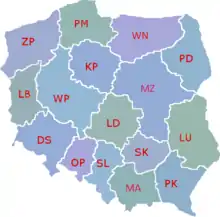
Administrative powers
Competences and powers at voivodeship level are shared between the voivode (governor), the sejmik (regional assembly) and the marshal. In most cases these institutions are all based in one city, but in Kuyavian-Pomeranian and Lubusz Voivodeship the voivode's offices are in a different city from those of the executive and the sejmik. Voivodeship capitals are listed in the table below.
The voivode is appointed by the Prime Minister and is the regional representative of the central government. The voivode acts as the head of central government institutions at regional level (such as the police and fire services, passport offices, and various inspectorates), manages central government property in the region, oversees the functioning of local government, coordinates actions in the field of public safety and environment protection, and exercises special powers in emergencies. The voivode's offices collectively are known as the urząd wojewódzki.[6]
The sejmik is elected every five years. (The first of the five-year terms began in 2018; previous terms lasted four years.)[7]) Elections for the sejmik fall at the same time as that of local authorities at powiat and gmina level. The sejmik passes by-laws, including the voivodeship's development strategies and budget. It also elects the marszałek and other members of the executive, and holds them to account.
The executive (zarząd województwa), headed by the marszałek drafts the budget and development strategies, implements the resolutions of the sejmik, manages the voivodeship's property, and deals with many aspects of regional policy, including management of European Union funding. The marshal's offices are collectively known as the urząd marszałkowski.
List
| Abbr. | Flag | Coat of arms | Ter. code | Voivodeship | Polish name | Capital cities | Area (km2)[8] | Population (2022)[8] | Pop. per km2[9] | Car plates | |
|---|---|---|---|---|---|---|---|---|---|---|---|
| DS |  |
02 | Lower Silesian | dolnośląskie | Wrocław | 19,947 | 2,903,000 | 145 | D | ||
| KP | 04 | Kuyavian-Pomeranian | kujawsko-pomorskie | Bydgoszcz1, Toruń2 | 17,971 | 2,056,000 | 115 | C | |||
| LU |  |
06 | Lublin | lubelskie | Lublin | 25,123 | 2,104,000 | 83 | L | ||
| LB |  |
08 | Lubusz | lubuskie | Gorzów Wielkopolski1, Zielona Góra2 | 13,988 | 995,000 | 72 | F | ||
| LD | 10 | Łódź | łódzkie | Łódź | 18,219 | 2,443,000 | 134 | E | |||
| MA |  |
12 | Lesser Poland | małopolskie | Kraków | 15,183 | 3,399,000 | 225 | K | ||
| MZ |  |
14 | Masovian | mazowieckie | Warsaw | 35,559 | 5,432,000 | 153 | W | ||
| OP |  |
16 | Opole | opolskie | Opole | 9,412 | 966,000 | 104 | O | ||
| PK |  |
18 | Subcarpathian | podkarpackie | Rzeszów | 17,846 | 2,098,000 | 119 | R | ||
| PD | 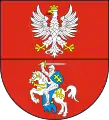 |
20 | Podlaskie | podlaskie | Białystok | 20,187 | 1,182,000 | 58 | B | ||
| PM | 22 | Pomeranian | pomorskie | Gdańsk | 18,323 | 2,355,000 | 128 | G | |||
| SL | 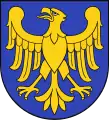 |
24 | Silesian | śląskie | Katowice | 12,333 | 4,501,000 | 364 | S | ||
| SK |  |
26 | Holy Cross | świętokrzyskie | Kielce | 11,710 | 1,216,000 | 105 | T | ||
| WN |  |
28 | Warmian-Masurian | warmińsko-mazurskie | Olsztyn | 24,173 | 1,423,000 | 59 | N | ||
| WP |  |
30 | Greater Poland | wielkopolskie | Poznań | 29,826 | 3,486,000 | 117 | P | ||
| ZP |  |
32 | West Pomeranian | zachodniopomorskie | Szczecin | 22,905 | 1,694,000 | 74 | Z | ||
| 1 Seat of voivode. 2 Seat of sejmik and marshal. | |||||||||||
Economies
According to 2017 Eurostat data, the GDP per capita of Polish voivodeships varies notably and there is a large gap between the richest per capita voivodeship (being the Masovian Voivodeship at 33,500 EUR) and the poorest per capita (being the Lublin Voivodeship at 14,400 EUR).[10]
Historical development

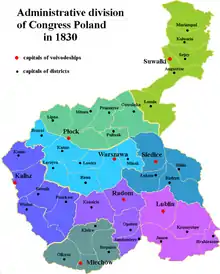
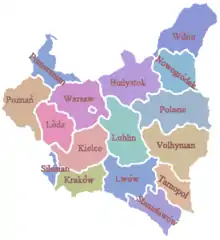

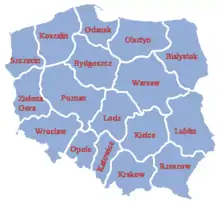

Greater Poland (Wielkopolska)
The following is a list of the Voivodeships within Greater Poland at various points over the period from the mid-16th century until the late 18th century:
- Poznań Voivodeship (województwo poznańskie, Poznań)
- Kalisz Voivodeship (województwo kaliskie, Kalisz)
- Gniezno Voivodeship (województwo gnieźnieńskie, Gniezno) from 1768
- Sieradz Voivodeship (województwo sieradzkie, Sieradz)
- Łęczyca Voivodeship (województwo łęczyckie, Łęczyca)
- Brześć Kujawski Voivodeship (województwo brzesko-kujawskie, Brześć Kujawski)
- Inowrocław Voivodeship (województwo inowrocławskie, Inowrocław)
- Chełmno Voivodeship (województwo chełmińskie, Chełmno)
- Malbork Voivodeship (województwo malborskie, Malbork)
- Pomeranian Voivodeship (województwo pomorskie, Gdańsk)
- Duchy of Warmia (Księstwo Warmińskie, Lidzbark Warmiński)
- Duchy of Prussia (Księstwo Pruskie, Królewiec)
- Płock Voivodeship (województwo płockie, Płock)
- Rawa Voivodeship (województwo rawskie, Rawa Mazowiecka)
- Masovian Voivodeship (województwo mazowieckie, Warszawa)
Lesser Poland (Małopolska)
The following is a list of the Voivodeships within Lesser Poland over the period of the mid-16th century until the late 18th century:
- Kraków Voivodeship (województwo krakowskie, Kraków)
- Sandomierz Voivodeship (województwo sandomierskie, Sandomierz)
- Lublin Voivodeship (województwo lubelskie, Lublin)
- Podlaskie Voivodeship (województwo podlaskie, Drohiczyn)
- Ruthenian Voivodeship (województwo ruskie, Lwów [today Lviv, Ukraine])
- Bełz Voivodeship (województwo belzkie, Bełz [Belz, Ukraine])
- Volhynian Voivodeship (województwo wołyńskie, Łuck [Lutsk, Ukraine])
- Podole Voivodeship (województwo podolskie, Kamieniec Podolski [Kamianets-Podilskyi, Ukraine])
- Bracław Voivodeship (województwo bracławskie, Bracław [Bratslav, Ukraine])
- Kijów Voivodeship (województwo kijowskie, Kijów [Kyiv, Ukraine, or Kiev])
- Czernihów Voivodeship (województwo czernichowskie, Czernihów [Chernihiv, Ukraine])
Grand Duchy of Lithuania
Voivodeships of the Grand Duchy of Lithuania during the Polish–Lithuanian Commonwealth were based on the administrative structure that existed in the Duchy prior to the Commonwealth's formation, from at least the early-15th century. They were:
- Wilno Voivodship (województwo wileńskie, Wilno [Vilnius, Lithuania])1413
- Troki Voivodship (województwo trockie, Troki [Trakai, Lithuania])
- Nowogrodek Voivodship (województwo nowogrodzkie, Nowogródek [Novogrudok, Belarus])
- Brest-Litovsk Voivodship (województwo brzesko-litewskie, Brześć Litewski [Brest, Belarus])
- Minsk Voivodship (województwo mińskie, Mińsk [Minsk, Belarus])
- Mscislaw Voivodship (województwo mścisławskie, Mścisław [Mstsislaw, Belarus])
- Smolensk Voivodship (województwo smoleńskie, Smoleńsk [Smolensk, Russia])
- Vitebsk Voivodship (województwo witebskie, Witebsk [Vitebsk, Belarus])
- Polock Voivodship (województwo połockie, Połock [Polotsk, Belarus])
- Duchy of Samogita (księstwo żmudzkie, Miedniki-Wornie [Varniai, Lithuania])
Duchy of Livonia
While the Duchy of Livonia was part of the Polish–Lithuanian Commonwealth, approximately 1569–1772, it was constituted by the following Voivodeships in varying combinations at different times:
- Wenden Voivodship (województwo wendeńskie, Wenden [Cēsis, Latvia]) since 1598 until the 1620s
- Dorpat Voivodship (województwo dorpackie, Dorpat [Tartu, Estonia]) since 1598 until the 1620s
- Parnawa Voivodship (województwo parnawskie, Parnava [Pärnu, Estonia]) since 1598 until the 1620s
- Inflanty Voivodeship (województwo inflanckie Dyneburg [Daugavpils, Latvia]) since the 1620s
- Duchy of Courland and Semigalia (księstwo Kurlandii i Semigalii), Mitawa [Jelgava, Latvia])
Congress Poland
From 1816 to 1837 there were 8 voivodeships in Congress Poland.
- Augustów Voivodeship
- Kalisz Voivodeship
- Kraków Voivodeship
- Lublin Voivodeship
- Mazowsze Voivodeship
- Płock Voivodeship
- Podlaskie Voivodeship
- Sandomierz Voivodeship
Second Polish Republic
The administrative division of Poland in the interwar period included 16 voivodeships and Warsaw (with voivodeship rights). The voivodeships that remained in Poland after World War II as a result of Polish–Soviet border agreement of August 1945 were very similar to the current voivodeships.
Collapsed list of car plates since 1937, please use table-sort buttons.
| Car plates (since 1937) | Voivodeship[11] | Polish name | Capital city modern name in parentheses | Area in km2 (1930) | Population (1931) |
|---|---|---|---|---|---|
| 20–24 | Białystok | białostockie | Białystok | 26,000 | 1,263,300 |
| 25–29 | Kielce | kieleckie | Kielce | 22,200 | 2,671,000 |
| 30–34 | Kraków | krakowskie | Kraków | 17,600 | 2,300,100 |
| 35–39 | Lublin | lubelskie | Lublin | 26,600 | 2,116,200 |
| 40–44 | Lwów | lwowskie | Lwów (Lviv) | 28,400 | 3,126,300 |
| 45–49 | Łódź | łódzkie | Łódź | 20,400 | 2,650,100 |
| 50–54 | Nowogródek | nowogródzkie | Nowogródek (Navahrudak) | 23,000 | 1,057,200 |
| 55–59 | Polesie | poleskie | Brześć nad Bugiem (Brest) | 36,700 | 1,132,200 |
| 60–64 | Pomeranian | pomorskie | Toruń | 25,700 | 1,884,400 |
| 65–69 | Poznań | poznańskie | Poznań | 28,100 | 2,339,600 |
| 70–74 | Stanisławów | stanisławowskie | Stanisławów (Ivano-Frankivsk) | 16,900 | 1,480,300 |
| 75–79? | Silesian | śląskie | Katowice | 5,100 | 1,533,500 |
| 80–84 | Tarnopol | tarnopolskie | Tarnopol (Ternopil) | 16,500 | 1,600,400 |
| 85–89 | Warsaw (voivodeship) | warszawskie | Warsaw | 31,700 | 2,460,900 |
| 00–19 | Warsaw (city) | Warszawa | Warsaw | 140 | 1,179,500 |
| 90–94 | Wilno | wileńskie | Wilno (Vilnius) | 29,000 | 1,276,000 |
| 95–99 | Wołyń | wołyńskie | Łuck (Lutsk) | 35,700 | 2,085,600 |
Polish People's Republic
After World War II, the new administrative division of the country within the new national borders was based on the prewar one and included 14 (+2) voivodeships, then 17 (+5). The voivodeships in the east that had not been annexed by the Soviet Union had their borders left almost unchanged. The newly acquired territories in the west and north were organized into the new voivodeships of Szczecin, Wrocław and Olsztyn, and partly joined to Gdańsk, Katowice and Poznań voivodeships. Two cities were granted voivodeship status: Warsaw and Łódź.
In 1950, new voivodeships were created: Koszalin (previously part of Szczecin), Opole (previously part of Katowice), and Zielona Góra (previously part of Poznań, Wrocław and Szczecin voivodeships). In 1957, three more cities were granted voivodeship status: Wrocław, Kraków and Poznań.
Collapsed list of car plates since 1956 – please use table-sort buttons
| Car plates (since 1956) | Voivodeship (Polish name) | Capital | Area in km2 (1965) | Population (1965) |
|---|---|---|---|---|
| A | białostockie | Białystok | 23,136 | 1,160,400 |
| B | bydgoskie | Bydgoszcz | 20,794 | 1,837,100 |
| G | gdańskie | Gdańsk | 10,984 | 1,352,800 |
| S | katowickie | Katowice | 9,518 | 3,524,300 |
| C | kieleckie | Kielce | 19,498 | 1,899,100 |
| E | koszalińskie1 | Koszalin | 17,974 | 755,100 |
| K | krakowskie | Kraków | 15,350 | 2,127,600 |
| ? | Kraków (city)2 | Kraków | 230 | 520,100 |
| F | łódzkie | Łódź | 17,064 | 1,665,200 |
| I | Łódź (city) | Łódź | 214 | 744,100 |
| L | lubelskie | Lublin | 24,829 | 1,900,500 |
| O | olsztyńskie | Olsztyn | 20,994 | 956,600 |
| H | opolskie ¹ | Opole | 9,506 | 1,009,200 |
| P | poznańskie | Poznań | 26,723 | 2,126,300 |
| ? | Poznań (city)2 | Poznań | 220 | 438,200 |
| R | rzeszowskie | Rzeszów | 18,658 | 1,692,800 |
| M | szczecińskie | Szczecin | 12,677 | 847,600 |
| T | warszawskie
|
Warsaw | 29,369 | 2,453,000 |
| W | Warszawa (city) | Warsaw | 446 | 1,252,600 |
| X | wrocławskie | Wrocław | 18,827 | 1,967,000 |
| ? | Wrocław (city)2 | Wrocław | 225 | 474,200 |
| Z | zielonogórskie1 | Zielona Góra | 14,514 | 847,200 |
| 1 New voivodeships created in 1950. 2 Cities separated in 1957. | ||||
Poland's voivodeships 1975–1998
Administrative division of Poland between 1979 and 1998 included 49 voivodeships upheld after the establishment of the Third Polish Republic in 1989 for another decade. This reorganization of administrative division of Poland was mainly a result of local government reform acts of 1973–1975. In place of the three-level administrative division (voivodeship, county, commune), a new two-level administrative division was introduced (49 small voivodeships, and communes). The three smallest voivodeships—Warsaw, Kraków and Łódź—had the special status of municipal voivodeship; the city president (mayor) was also provincial governor.
Collapsed list of Voivodeships: 1975–1998, please use table-sort buttons.
| Abbr. | Voivodeship | Polish name | Capital | Area km2 (1998) | Population (1980) | No. of cities | No. of communes |
|---|---|---|---|---|---|---|---|
| bp | Biała Podlaska Voivodeship | bialskopodlaskie | Biała Podlaska | 5,348 | 286,400 | 6 | 35 |
| bk | Białystok Voivodeship | białostockie | Białystok | 10,055 | 641,100 | 17 | 49 |
| bb | Bielsko-Biała Voivodeship | bielskie | Bielsko-Biała | 3,704 | 829,900 | 18 | 47 |
| by | Bydgoszcz Voivodeship | bydgoskie | Bydgoszcz | 10,349 | 1,036,000 | 27 | 55 |
| ch | Chełm Voivodeship | chełmskie | Chełm | 3,865 | 230,900 | 4 | 25 |
| ci | Ciechanów Voivodeship | ciechanowskie | Ciechanów | 6,362 | 405,400 | 9 | 45 |
| cz | Częstochowa Voivodeship | częstochowskie | Częstochowa | 6,182 | 747,900 | 17 | 49 |
| el | Elbląg Voivodeship | elbląskie | Elbląg | 6,103 | 441,500 | 15 | 37 |
| gd | Gdańsk Voivodeship | gdańskie | Gdańsk | 7,394 | 1,333,800 | 19 | 43 |
| go | Gorzów Voivodeship | gorzowskie | Gorzów Wielkopolski | 8,484 | 455,400 | 21 | 38 |
| jg | Jelenia Góra Voivodeship | jeleniogórskie | Jelenia Góra | 4,378 | 492,600 | 24 | 28 |
| kl | Kalisz Voivodeship | kaliskie | Kalisz | 6,512 | 668,000 | 20 | 53 |
| ka | Katowice Voivodeship | katowickie | Katowice | 6,650 | 3,733,900 | 43 | 46 |
| ki | Kielce Voivodeship | kieleckie | Kielce | 9,211 | 1,068,700 | 17 | 69 |
| kn | Konin Voivodeship | konińskie | Konin | 5,139 | 441,200 | 18 | 43 |
| ko | Koszalin Voivodeship | koszalińskie | Koszalin | 8,470 | 462,200 | 17 | 35 |
| kr | Kraków Voivodeship | krakowskie | Kraków | 3,254 | 1,167,500 | 10 | 38 |
| ks | Krosno Voivodeship | krośnieńskie | Krosno | 5,702 | 448,200 | 12 | 37 |
| lg | Legnica Voivodeship | legnickie | Legnica | 4,037 | 458,900 | 11 | 31 |
| le | Leszno Voivodeship | leszczyńskie | Leszno | 4,254 | 357,600 | 19 | 28 |
| lu | Lublin Voivodeship | lubelskie | Lublin | 6,793 | 935,200 | 16 | 62 |
| lo | Łomża Voivodeship | łomżyńskie | Łomża | 6,684 | 325,800 | 12 | 39 |
| ld | Łódź Voivodeship | łódzkie | Łódź | 1523 | 1,127,800 | 8 | 11 |
| ns | Nowy Sącz Voivodeship | nowosądeckie | Nowy Sącz | 5,576 | 628,800 | 14 | 41 |
| ol | Olsztyn Voivodeship | olsztyńskie | Olsztyn | 12,327 | 681,400 | 21 | 48 |
| op | Opole Voivodeship | opolskie | Opole | 8,535 | 975,000 | 29 | 61 |
| os | Ostrołęka Voivodeship | ostrołęckie | Ostrołęka | 6,498 | 371,400 | 9 | 38 |
| pi | Piła Voivodeship | pilskie | Piła | 8,205 | 437,100 | 24 | 35 |
| pt | Piotrków Voivodeship | piotrkowskie | Piotrków Trybunalski | 6,266 | 604,200 | 10 | 51 |
| pl | Płock Voivodeship | płockie | Płock | 5,117 | 496,100 | 9 | 44 |
| po | Poznań Voivodeship | poznańskie | Poznań | 8,151 | 1,237,800 | 33 | 57 |
| pr | Przemyśl Voivodeship | przemyskie | Przemyśl | 4,437 | 380,000 | 9 | 35 |
| ra | Radom Voivodeship | radomskie | Radom | 7,295 | 702,300 | 15 | 61 |
| rz | Rzeszów Voivodeship | rzeszowskie | Rzeszów | 4,397 | 648,900 | 13 | 41 |
| se | Siedlce Voivodeship | siedleckie | Siedlce | 8,499 | 616,300 | 12 | 66 |
| si | Sieradz Voivodeship | sieradzkie | Sieradz | 4,869 | 392,300 | 9 | 40 |
| sk | Skierniewice Voivodeship | skierniewickie | Skierniewice | 3,959 | 396,900 | 8 | 36 |
| sl | Słupsk Voivodeship | słupskie | Słupsk | 7,453 | 369,800 | 11 | 31 |
| su | Suwałki Voivodeship | suwalskie | Suwałki | 10,490 | 422,600 | 14 | 42 |
| sz | Szczecin Voivodeship | szczecińskie | Szczecin | 9,981 | 897,900 | 29 | 50 |
| tg | Tarnobrzeg Voivodeship | tarnobrzeskie | Tarnobrzeg | 6,283 | 556,300 | 14 | 46 |
| ta | Tarnów Voivodeship | tarnowskie | Tarnów | 4,151 | 607,000 | 9 | 41 |
| to | Toruń Voivodeship | toruńskie | Toruń | 5,348 | 610,800 | 13 | 41 |
| wb | Wałbrzych Voivodeship | wałbrzyskie | Wałbrzych | 4,168 | 716,100 | 31 | 30 |
| wa | Warsaw Voivodeship | warszawskie | Warsaw (Warszawa) | 3,788 | 2,319,100 | 27 | 32 |
| wl | Włocławek Voivodeship | włocławskie | Włocławek | 4,402 | 413,400 | 14 | 30 |
| wr | Wrocław Voivodeship | wrocławskie | Wrocław | 6,287 | 1,076,200 | 16 | 33 |
| za | Zamość Voivodeship | zamojskie | Zamość | 6,980 | 472,100 | 5 | 47 |
| zg | Zielona Góra Voivodeship | zielonogórskie | Zielona Góra | 8,868 | 609,200 | 26 | 50 |
See also
- Armorial of Poland
- Flags of Polish voivodeships
- ISO 3166-2:PL
- List of Polish voivodeships by GRP
- Prowincja, provinces in Poland
- Polish historical regions
Notes
- The word voivodeship, as an equivalent for województwo, appears in some large English dictionaries such as the OED and Webster's Third New International Dictionary but is not in common English usage. Hence the word province is a recommended translation: "Jednostki podziału administracyjnego Polski tłumaczymy tak: województwo—province..." ("Polish administrative units are translated as follows: województwo—province..."). Arkadiusz Belczyk, "Tłumaczenie polskich nazw geograficznych na język angielski" Archived 2016-03-03 at the Wayback Machine ("Translation of Polish Geographical Names into English"), 2002-2006. Examples: New Provinces of Poland (1998) Archived 2011-06-08 at the Wayback Machine, Map of Poland, English names of Polish provinces. More examples:
- "Following the reform of the administrative structure in 1973-1975, the number of provinces (województwo) was increased from 22 to 49... [I]ncreasing the number of provinces meant the reduction of each in size. In this way Warsaw was able to dilute the political importance of the provincial party chiefs." "Poland", The Encyclopedia Americana, 1986, volume 22, p. 312.
- "Poland is divided into 49 provinces." "Poland", The Columbia Encyclopedia, sixth edition, edited by Paul Lagassé, Columbia University Press, 2000, p. 2256.
- "Local government in Poland is organized on three levels. The largest units, at the regional level, are the województwa ('provinces')..." "Poland", Encyclopædia Britannica, 15th edition, 2010, Macropaedia, volume 25, p. 937.
- "GOVERNMENT... Administrative divisions: 16 provinces (województwa, singular–województwo)..." "Poland," in Central Intelligence Agency, The CIA World Factbook 2010, New York, Skyhorse Publishing, Inc., 2009, ISBN 9781602397279, p. 546. The same information appears in the current online CIA World Factbook --> "Poland --> Administrative divisions". Note that in this source, where "English translations" of province names are given, they are in the noun ("Silesia"), not the adjective ("Silesian"), form.
- Professor Paul Best, of Southern Connecticut State University, writes: "[I]n standard dictionaries the Polish word województwo is translated as 'province'." Paul Best, review of Bogdan Horbal, Lemko Studies: A Handbook (2010), in The Polish Review, vol. 58, no. 4 (2013), pp. 125–26.
- "Voivodeship," The Oxford English Dictionary, second edition, volume XIX, Oxford, Clarendon Press, 1989, p. 739.
- http://ksng.gugik.gov.pl/pliki/topon_inte.doc.pdf Archived 2019-11-24 at the Wayback Machine
- http://ksng.gugik.gov.pl/english/sopgn.php Archived 2021-09-07 at the Wayback Machine
- http://ksng.gugik.gov.pl/pliki/gegn22wp18.pdf
- Granat, Miroslaw; Granat, Katarzyna (28 November 2019). The Constitution of Poland: A Contextual Analysis. Bloomsbury Publishing. p. 172. ISBN 978-1-5099-1396-1.
- "Samorządowcy dostali dodatkowy rok. Jak wykorzystają 5-letnią kadencję? - Prawo i finanse".
- "Powierzchnia i ludność w przekroju terytorialnym w 2021 roku". GUS. 2021.
- "Powierzchnia i ludność w przekroju terytorialnym w 2021 roku". GUS. 2021.
- "Eurostat - Tables, Graphs and Maps Interface (TGM) map". ec.europa.eu. Retrieved 2017-02-16.
- data as per April 1, 1937
References
- "Poland", Encyclopædia Britannica, 15th edition, 2010, Macropaedia, volume 25, p. 937.
- "Poland", The Columbia Encyclopedia, sixth edition, edited by Paul Lagassé, Columbia University Press, 2000, p. 2256.
- "Poland", The Encyclopedia Americana, 1986, volume 22, p. 312.
- "Poland," in Central Intelligence Agency, The CIA World Factbook 2010, New York, Skyhorse Publishing, Inc., 2009, ISBN 9781602397279, p. 546.
- "Voivodeship," The Oxford English Dictionary, second edition, volume XIX, Oxford, Clarendon Press, 1989, p. 739.
External links
- Map of Polish Regions Archived 2005-04-16 at the Wayback Machine
- Administrative division of Poland (from Commission on Standardization of Geographical Names Outside Poland website, in English) Archived 2006-09-25 at the Wayback Machine
- Official map by Head Office of Geodesy and Cartography Archived 2007-03-11 at archive.today
- Regions of Poland Archived 2010-07-26 at the Wayback Machine
- Toponymic Guidelines Of Poland for Map Editors and Other Users Archived 2019-11-24 at the Wayback Machine Head Office Of Geodesy And Cartography, 2002
- CIA World Factbook --> "Poland --> Administrative divisions"